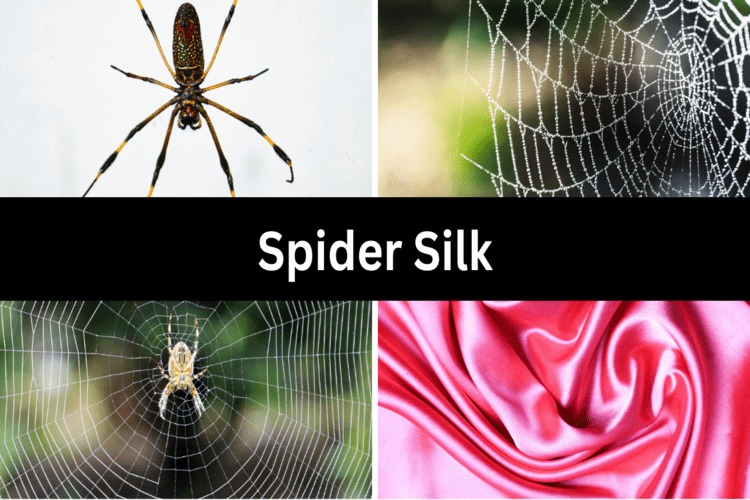History of Spider Silk
Most of the silk came from silkworms, but some folks also used spider silk. Early Romans and Greeks wove spider silk into fabrics and nets and used it to treat injuries. Australian aborigines used spider silk for fishing lines and nets, sometimes crushing spiders onto the nets to attract fish. Before World War II, weapon crosshairs were often made from spider silk.
Properties of Spider silk
Spider silk packs incredible strength, surpassing steel in its strength-to-weight ratio. Pound for pound, it’s five times tougher than steel of comparable thickness. Some propose that a single strand as thin as a pencil could bring a Boeing 747 to a halt mid-flight. Spider silk is nearly as sturdy as Kevlar, the toughest synthetic polymer known. Thinner than human hair, most spider silk threads measure only a few microns across and maintain their resilience even in temperatures below -40°C. The toughest silk hails from the Golden Orb-Weaving spider, known for weaving webs with a golden hue.
What sets spider silk apart isn’t just its strength but also its remarkable elasticity. Capture silk, utilized for ensnaring prey, stretches to 2-4 times its original length without breaking. Spider silk outperforms silkworm silk in durability, flexibility, and resistance to water, hinting at a wide array of potential uses. It’s no wonder that materials chemists are captivated by spider silk’s potential, as it could pave the way for the creation of groundbreaking ultra-strong fibers.
Composition of spider silk fiber
The spider’s anatomy is pretty simple, mostly made up of the cephalothorax and the abdomen, with support from lumbar areas. The cephalothorax includes the forelimbs, head, and chest, along with eight flexible legs for crawling. Most spiders have spinners on their abdomen, usually about 6 to 8 of them. Spider silk isn’t made from a single strand but comes from different glands inside the spider’s body, like the large cystic gland, grape-like gland, flagellar gland, small cystic gland, aggregate gland, and bamboo shoot gland.
There are lots of spider species, each making different kinds of silk. Even within the same species, different glands produce different types of silk, each with its own uses. For example, capture silk catches prey, drag silk helps in building webs and escaping, frame silk creates the outer structure of the web, taenidium silk acts as a fastener and connector, and egg cocoon silk forms nests for offspring.
Although spider silk comes in many varieties, it shares some common traits: it’s mostly made of amino acids like glycine, alanine, and serine, creating a high-molecular protein. Spider silk has better crystalline and non-crystalline sections compared to other natural fibers, making it super strong, elastic, resistant to breaking, and biodegradable. In a time of widespread environmental pollution and fast-paced technology, spider silk shines as a top-notch textile material, offering special qualities and exciting possibilities.
Applications of Spider Silk
Throughout history, humans have tapped into the potential of spider silk. The ancient Greeks used cobwebs to stop bleeding wounds, and Aborigines crafted silk into fishing lines. In more recent times, silk acted as crosshairs in guns and telescopes until World War II, and today, people in the Solomon Islands still use silk for fishnets.
Contemporary research explores spider silk’s remarkable strength and versatility. Interest in spider silk arises from its mechanical capabilities and its eco-friendly production process. Unlike modern super-fibers like Kevlar, which involve petrochemicals and sulfuric acid, spider silk is produced by spiders in an environmentally friendly way, drawn from water at normal temperature and pressure. Additionally, silk is fully biodegradable. If spider silk production becomes feasible on an industrial scale, it could replace Kevlar and be used in a wide range of applications, from bulletproof vests and durable clothing to ropes, nets, and biodegradable medical supplies such as bandages and surgical thread.
Conclusion
Spider silk shines as an extraordinary natural textile material, boasting remarkable qualities. In today’s world, where environmental concerns take center stage and eco-friendly practices gain momentum, spider silk fibers are poised for continued exploration and expansion across diverse fields, driven by advancements in science and technology.
Yet, several practical challenges impede the broad adoption of spider silk. Spiders, being carnivorous and solitary by nature, aren’t easily tamed like other animals and can’t be bred on a large scale like silkworms. Moreover, spiders produce a variety of silk types, complicating the process of sorting and selecting specific varieties for mass production. Consequently, natural spider silk remains challenging to produce in significant quantities, resulting in high costs and limiting its widespread use compared to conventional silk. Thus, significant efforts and resources must be dedicated to discovering novel methods and techniques for obtaining natural materials with properties akin to spider silk in the future.
You may also like:
- Count of Yarn: Explanation and Varieties
- Yarn Manufacturing Process
- What is Hemp Fiber? Properties, Advantages and Disadvantages.
- What is Ramie Fiber? Properties, Advantages and Disadvantages.
- What is Sisal Fiber? Properties, Structure, and How It Made?
- Pina Fiber: History, Properties, Production Process
- Coir Fiber: Properties, Production Process and Advantages
- Rayon Fiber: History, Properties, Advantages and Disadvantages
- Acrylic Fiber: History, Properties, Advantages and Disadvantages
- Nylon Fiber: Properties, Advantages and Disadvantages
Share this Article!

